Journal of the Mexican Chemical Society, vol. 65, no. 3, 2021
Sociedad Química de México A.C.
Norbaya Hashim *
Malaysia-Japan International Institute of Technology (MJIIT), University Teknologi Malaysia (UTM), 54100 Kuala Lumpur, Malaysia., Malaysia
National Water Research Institutes of Malaysia (NAHRIM), 43600 Seri Kembangan, Selangor, Malaysia., Malaysia
Ali Yuzir
Malaysia-Japan International Institute of Technology (MJIIT), University Teknologi Malaysia (UTM), 54100 Kuala Lumpur, Malaysia., Malaysia
Fouad Fadhil Al-Qaim
Department of Chemistry, College of Science for Women, University of Babylon, P.O. Box 4, 51 Babylon, Iraq., Iraq
Nasehir Khan E.M. Yahaya
National Water Research Institutes of Malaysia (NAHRIM), 43600 Seri Kembangan, Selangor, Malaysia., Malaysia
Received: 22 December 2020
Accepted: 24 March 2021
Abstract: This review focuses on the occurrence and distribution of 17 targeted human pharmaceutical compounds from the most common therapeutic classes. These include one analgesic (acetaminophen), three non-steroidal anti-inflammatory drugs (NSAIDs) (acetylsalicylic acid, diclofenac, ibuprofen), two antidiabetic drugs (gliclazide, metformin), three antihistamines (cetirizine, chlorphenamine, ranitidine), four antihypertensives (amlodipine, atenolol, metoprolol, prazosin), one lipid regulator (simvastatin), one anti-convulsant (carbamazepine), one bronchodilator agent (salbutamol) and one stimulant (caffeine) which have been detected globally in various aquatic environmental matrices such as surface water, drinking water, ground water, seawater, influent and effluent of municipal wastewater treatment plants (WWTPs), hospital and industrial treatment plants, among others. The most common analytical method used involved solid phase extraction (SPE) and liquid chromatography coupled to mass spectrometry. The concentrations of all drugs investigated in all aqueous matrices varied from 0.5 to 85,000 ng/L for the highest concentration in the aqueous matrices in Southeast Asia. This review provides the first compilation on human pharmaceuticals in Southeast Asia in surface water, domestic wastewater (influent and effluent) and drinking water.
Keywords: Pharmaceutical, Malaysian aquatic environment, LC-MS/MS, Southeast Asia.
Resumen: Esta revisión se centró en la aparición y distribución de 17 fármacos de uso humano pertenecientes a las clases terapéuticas más comunes y consiste en un analgésico (acetaminofeno), tres medicamentos antiinflamatorios no esteroideos (AINE) (ácido acetilsalicílico, diclofenaco, ibuprofeno), dos antidiabéticos (gliclazida, metformina), tres antihistamínicos (cetirizina, clorfenamina, ranitidina), cuatro antihipertensivos ( atenolol, metoprolol, prazosina), un regulador de lípidos (simvastatina), un anticonvulsivo (carbamazepina), un agente broncodilatador (salbutamol) y un estimulante (cafeína), y que se han detectado globalmente en varios tipos de matrices ambientales acuáticas como el agua superficial, agua potable, agua subterránea, agua de mar, afluente y efluente de plantas de tratamiento de aguas residuales municipales (EDAR), plantas de tratamiento hospitalarias e industriales entre otras. El método analítico más utilizado involucró extracción en fase sólida (SPE) y cromatografía líquida acoplada a espectrometría de masas. Las concentraciones de todos los fármacos investigados en todas las matrices acuosas variaron de 0,5 a 85.000 ng / L, y presentaron la concentración más alta en las matrices acuosas en el país del sudeste asiático. Esta revisión proporciona el primer informe recopilatorio sobre un estudio de productos farmacéuticos humanos que se ha realizado en el sudeste asiático y se centra en aguas superficiales, aguas residuales domésticas (afluentes y efluentes) y agua potable.
Palabras clave: Farmacéutica, medio acuático de Malasia, LC-MS / MS, Sudeste de Asia.
Introduction
The issue of pharmaceutical pollution in aquatic environments has received critical attention globally since the first determination of pharmaceutical compounds i.e. colibric acid and salicylic acid was reported in 1971 with a concentration of 1-2 µg/L in the German municipal sewage [1]. Expanding from that, various water matrices have been investigated to confirm the ubiquitous and widespread presence of such compounds in drinking water [2,3], surface water [4,5], wastewater from municipal, hospital and industrial sewage plants [6-10], groundwater [11,12] seawater [13, 14] and even swimming pools [15,16]. Global concern has arisen due to the potential risks and adverse health effects among aquatic organisms, wildlife and humans through water consumption or food chain, although the specific effects of these compounds are little known or unclear [17]. The presence of several pharmaceutical compounds especially in drinking water has increased health concerns in the public since these compounds are usually designed to be biologically active and interact with specific pathways and processes in humans and animals [18]. Although the concentration of any given drug might be very low (in the range of few ng/L) compared to the therapeutic doses (in the ranges of milligrams), consideration must be given to the combinatory effects and toxicological concerns regarding the release of pharmaceuticals in the environment, including the inducement of abnormal physiological processes and reproductive impairment, increased incidences of cancer, development of antibiotic resistant bacteria and the potential for increased toxicities when complex chemical mixtures sharing a similar mode of action occur in the environment [19,20]. Consequently, several pharmaceutical compounds have been classified as potential endocrine disruptors, such as diclofenac [21] and metformin [22], which are capable of disrupting the human endocrine system and wildlife.
Pharmaceuticals are a diverse group of chemicals either synthetic or natural that consist of prescription medicines, over-the counter therapeutic drugs and veterinary drugs which aid the diagnosis, cure, treatment, or prevention of disease [23]. The extensive use of pharmaceuticals has led to the increased presence of these emerging pollutants in the source water of the sewage treatment plants (STPs) [24]. Pharmaceuticals taken by humans that are not completely absorbed in the bodies will enter wastewater during excretion (urine and feces) together with their metabolites/ transformation products. However, conventional STPs are not designed to eliminate these complex, multiple-classed micro-pollutants, thus carrying those residues via effluent discharge into the receiving river. Other sources may also come from groundwater leachate, production residues, improper disposal of expired medicines and unused drugs, landfill leachates and accidental spillage during manufacturing and distribution of drugs, all of which eventually end up in surface water and the groundwater system [25]. A raw water supply from aquatic environments such as rivers, lakes or groundwater which contains these pharmaceutical residues will be then treated and supplied as drinking water to residential areas. Again, conventional drinking water treatment systems also have limited capability to eliminate these micropollutants; thus, humans can be exposed to these pharmaceutical residues via drinking water consumption [26].
Southeast Asia (SEA) consists of 11 countries including Brunei, Cambodia, Malaysia, Laos, Vietnam, Singapore, Indonesia, Myanmar, Philippines, Thailand and Timor-Leste (Fig. 1). Relatively little is known about the occurrence of the pharmaceuticals in water bodies in developing Southeast Asian countries, as the use of pharmaceuticals is rapidly growing, and environmental regulations are not well established. Even so, there are a few publications on the occurrence of selected pharmaceuticals studied in SEA that have been reported in surface water [27], seawater [28], wastewater from domestic and hospital sewage treatment plants [6] and groundwater [29]. Conversely, such studies have been well documented in several developed regions such as Europe [30,31] America [33,34], the United Kingdom [13,35], the United Arab Emirates [13,35], Australia [36,37], China [38,39], India [40,41], Japan [42,43] and Korea [44,45]. Other non-targeted compounds reviewed in this paper also have been investigated previously in SEA water bodies, including antibiotics and hormones [46-48]. SEA may have been neglected by studies such as these because the pollutants are not regulated yet as environmental pollutants. Additionally, detecting very low or trace level concentrations requires expensive and highly sensitivity analytical instruments [20].
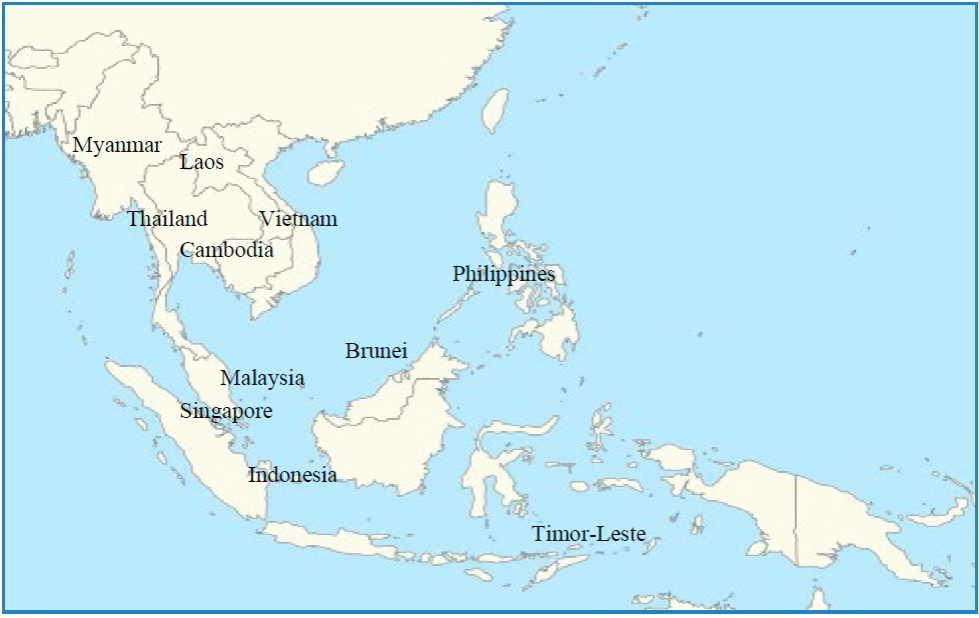
Fig. 1
Maps of South East Asia (SEA) countries.
Thus, this review aims to provide comprehensive information on the occurrence and distribution of 17 selected human pharmaceutical compounds in different aquatic environments, focusing in surface water and domestic wastewater (influent and effluent) in Southeast Asia and with particular reference to Malaysia. There are no reports available in the literature on the occurrence of the targeted compounds in drinking water matrices in Malaysia and other Asian countries. The analytical methods and procedures used for sample preparation (extraction), detection and quantification of these pharmaceuticals are also presented. To the best of the authors’ knowledge, this is the first comprehensive review of the occurrence and distribution of pharmaceuticals in Southeast Asia. The data compiled in this study will serve as reference and baseline for future research aimed towards the prevention and mitigation of environmental water safety and security around the world.
Experimental
Selected pharmaceuticals
Target compounds
This review focuses on 17 target pharmaceutical compounds representing a wide range of different therapeutic classes. The molecular structures of these target compounds are shown in Fig. 2. Malaysia has been taken as a reference for selecting pharmaceutical compounds in this study. Fourteen (14) of these have been selected based on top 50 medicines utilized in the last published Malaysian Statistic of Medicine 2011-2014 report [49] i.e. amlodipine (AML), gliclazide (GLI), metformin (MEF), simvastatin (SIM), atenolol (ATE), acetylsalicylic acid (ASA), metoprolol (MET), acetaminophen (ACE), cetirizine (CET), salbutamol (SAL), chlorphenamine (CHL), ranitidine (RAN), diclofenac (DIC) and prazosin (PRA). The other three (3) compounds i.e. caffeine (CAF), carbamazepine (CBZ) and ibuprofen (IBU) have been selected based on previous high frequency detection in Southeast Asian environment water samples [27,28,50] as well as in other countries [34, 51-53]. A few of the pharmaceuticals selected in this study are also classified as over-the-counter (OTC) medicines in Malaysia, such as ACE and ASA, while some have been reported as having potential to be endocrine disruptors, such as DIC [21] and MEF [22].
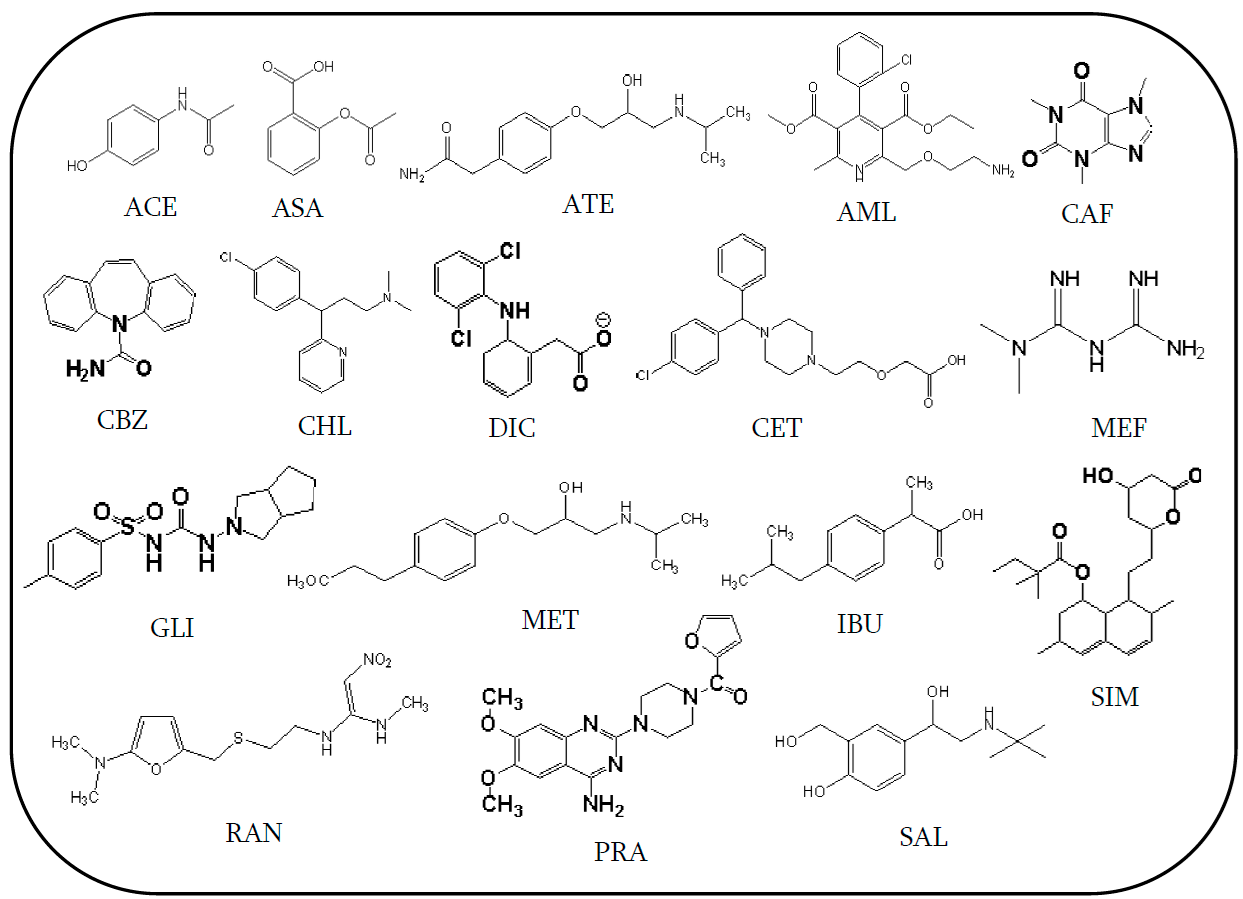
Fig. 2
Molecular structure of 17 targeted compounds.
Drug consumption in Malaysia
Drug consumption or usage patterns for a given country may differ from other countries or even between areas within that country due to numerous factors including differences of demographic, epidemiology of disease, medical approaches or economic conditions [54]. The consumption of drugs in a country affects the presence of these drugs in its aquatic environment, particularly in sewage. In Malaysia, pharmaceutical use is published by the Ministry of Health (MOH) via Malaysian Statistics of Medicines (MSOM) since 2006. They report on the pattern of medicine consumption in the country both from public and private sectors. The Anatomical Therapeutic Chemical (ATC) code set by World Health Organization (WHO) is used as an international classification system to present the statistics of medicine use in Malaysia, and the unit of measurement is based on defined daily doses (DDDs) per- 1,000 population per -day. Based on the ATC code, the target pharmaceuticals with ranking among top 50 drugs (2014) are shown in Table 1.
Top 50 drugs by utilization in Malaysia, 2014 [49].
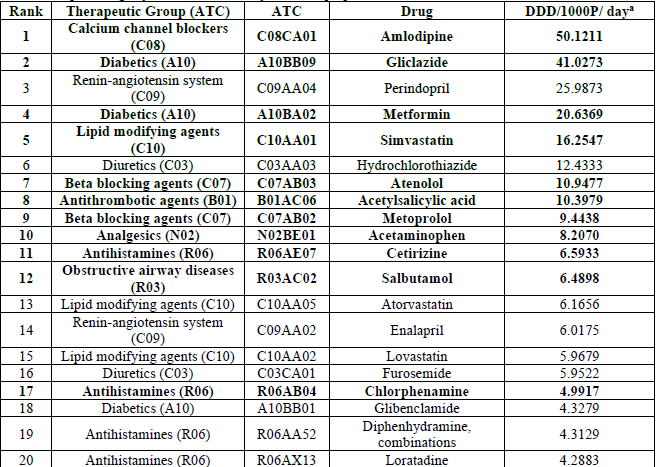
Top 50 drugs by utilization in Malaysia, 2014 [49]. (Cont.)
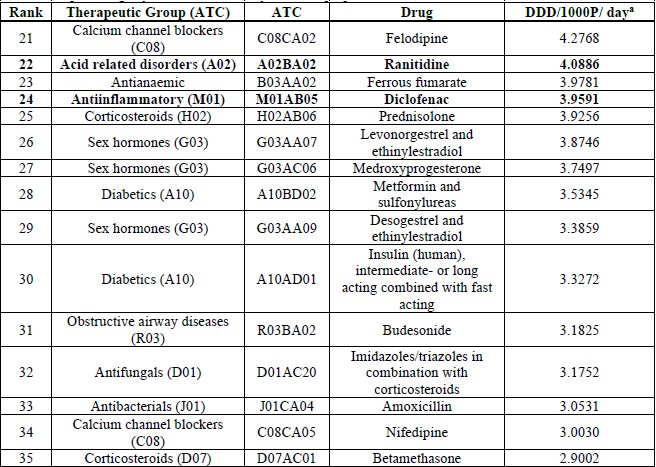
Top 50 drugs by utilization in Malaysia, 2014 [49]. (Cont.)
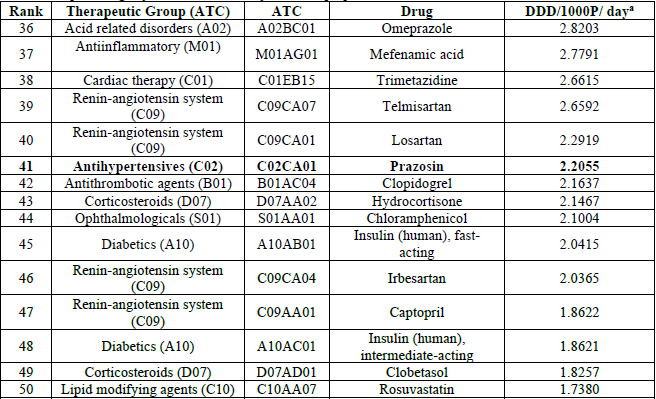
National estimates for use of target compound studied in Malaysia for ten years (2004 to 2014) are presented in Fig. 3. An antihypertensive (AML) and antidiabetic (GLI) were among the most commonly used drugs among the Malaysian population.
Physico-chemical properties of target compounds
The physical and chemical properties of pharmaceuticals, such as molecular weight, acid dissociation constant (pKa), octanol/water partition coefficient (Log Kow), solubility, vapor pressure or Henry’s law constant (KH), provide important information about the transportation of chemicals in the human body in addition to the air-water-soil environment compartment and also the transport between immiscible phases during analytical extraction. Log Kow, also referred as Log P, determined the hydrophobicity based on the n-octanol reference system. The larger the value of Kow, the greater is the tendency of a solute to escape from water and transfer to a bulk hydrophobic phase. Log Kow can be defined as low, if its value is less than 2.7, medium, if 2.7 ≤ log Kow ≤3.0 and high, when the value is larger than 3.0. Solubility is the maximum amount of a chemical that can be dissolved into another at a given temperature. Vapor pressure refers to the volatility of a pure substance into the atmosphere, while Henry’s law constant refers to the volatility of a compound from liquid solution into the air. The larger the magnitude of the Henry’s law constant, the greater the tendency for volatilization from the liquid solvent into the gaseous phase. These properties are vital in determining whether a compound is more likely to concentrate in the aquatic or atmospheric environmental compartment. Vapor pressure and water solubility can be ranked as low, medium and high with values of 10-6, 10-6<KH<10 -2 and >10-2 mm Hg, for the former, and <10 ppm, 10-1000 ppm and >1000 ppm, for the latter. Generally, high water solubility is accompanied by low hydrophobicity. The pH of the aqueous phase determines the distribution of ionized-non ionized species in the solution. When the solution pH = pKa, half of the compound is ionized while half is non-ionized. When pH > pKa for compound, the ionized species become predominant and vice versa [59]. The physicochemical properties of target compounds are shown in Table 2.
Sample preparation and analytical techniques
The key for the successful detection of the trace level pharmaceutical residues (ng/L to lower µg/L) in various environmental water samples is largely attributed to advances in analytical techniques and instrumentation currently available [60]. Since there is no standard method at present to detect vast number of pharmaceuticals currently in use, it is necessary the continuous development of new analytical method [61]. Developing techniques for pharmaceuticals analysis is challenging because drugs represent a broad spectrum of compounds with their unique physical and chemical properties [62]. Sample preparation is the most tedious and time-consuming step and the source of much imprecision and inaccuracy of the overall analysis [63]. This step requires the removal of interfering compounds from the sample, isolate analytes, enrich the analyte or improve the detection properties through derivatization [64]. Among a number of extraction techniques, solid phase extraction (SPE) allows simultaneous extraction, sample clean up and sample concentration and can be performed either online or offline.
Various analysis techniques have been found to be suitable for reliable detection of such drugs compounds in the aqueous environmental matrices. However, a highly sensitive method is required to attain lower ng/L of quantitation limits. The separation of non- volatile to mid-volatile compound with high hydrophilicity characteristic such as pharmaceutical compounds is often best carried out by using liquid chromatography (LC) [65]. However, other analytical approaches such as gas chromatography (GC) have also been reported to separate these compounds by adding derivatization agents such as PFBBr, BSTFA, or TMCS to increase compound volatility prior to analysis [66,67]. Among the various detectors used in conjunction with LC, mass spectrometry (MS) has become one of the most widely used in pharmaceutical method development because it allows quick molecular weight confirmation and structure identification. Other detectors that can be used include the diode array detector (DAD) and ultraviolet (UV) detector [68-71].
Nowadays, a combination of advanced solid phase materials together with analytical instruments such as ultra-high-performance liquid chromatography tandem mass spectrometry (UHPLC-MS/MS) is the most suitable approach [1,60]. Numerous applications of LC-ESI-MS/MS have been reported for determining the presence of pharmaceuticals in environmental water samples [72-74] since it allows the determination of a broader range of polar compounds and thus permit more comprehensive assessment of environmental contaminants. LC-MS-MS offers very good sensitivity and selectivity in the trace analysis of environmental pollutants [75].
The analytical techniques for detecting the compounds targeted in this study in different water matrices are presented in Table 3. The influence of the type of SPE (online and offline) occupied and SPE cartridges used on the recovery result have also been highlighted. The detection limits for each analysis are also shown.
Analytical techniques involved in pharmaceuticals analysis in water environmental sample.
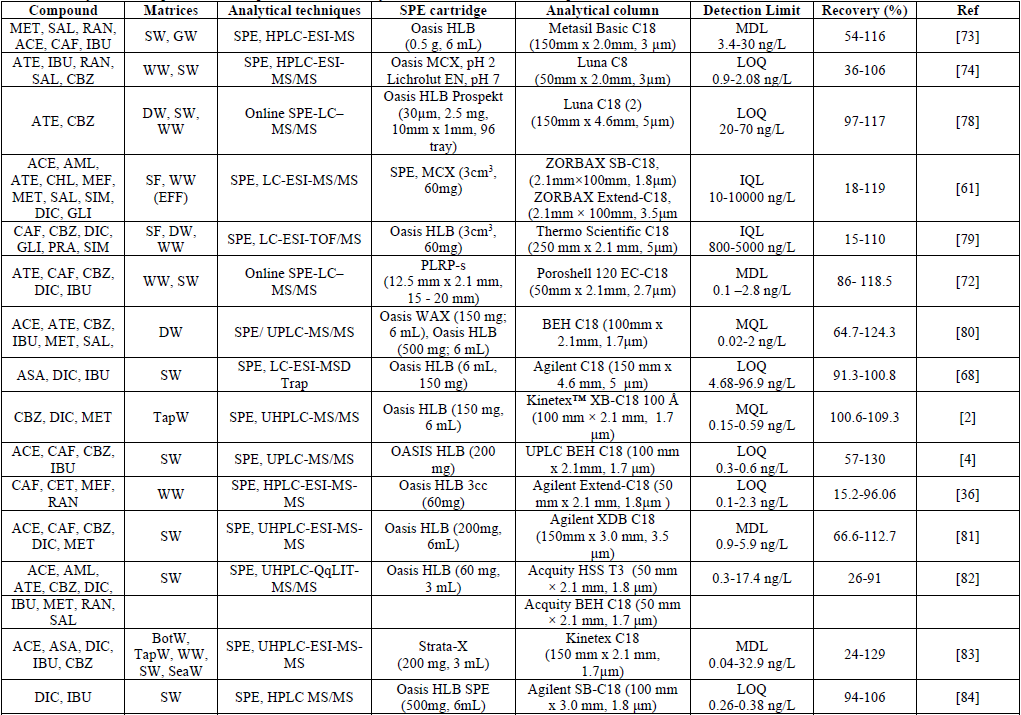
Occurrence and distribution of targeted human pharmaceuticals in various water matrices in SEA countries
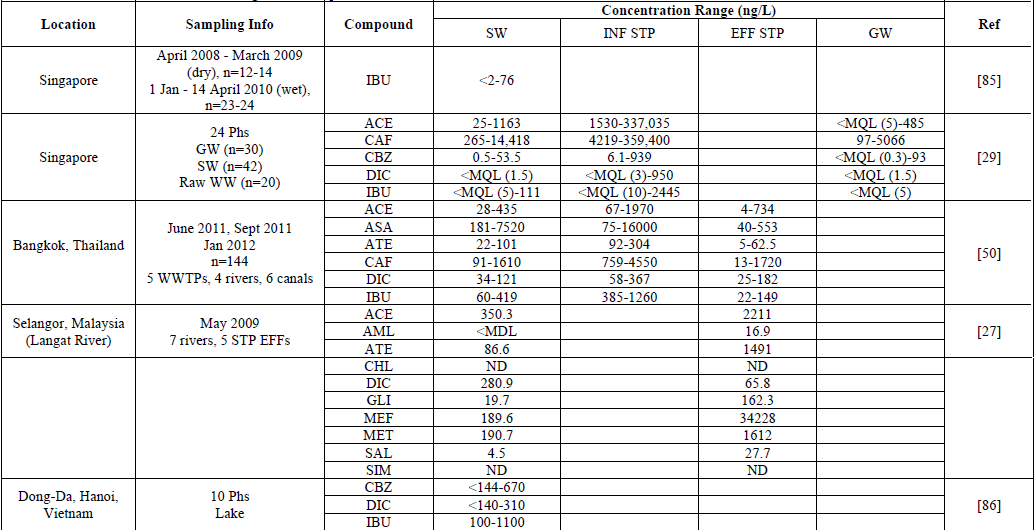
Occurrence and distribution of targeted human pharmaceuticals in various water matrices in SEA countries (Cont.)
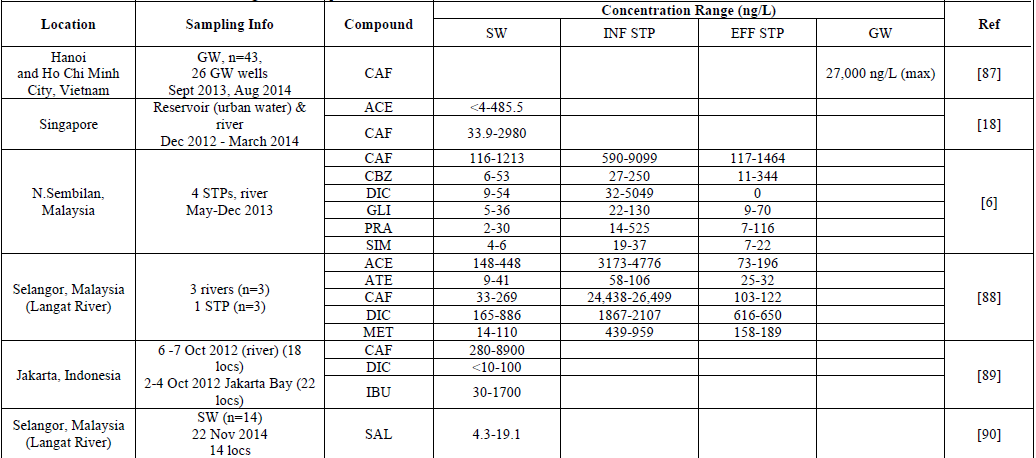
Occurrence and distribution of targeted human pharmaceuticals in various water matrices in SEA countries (Cont.)
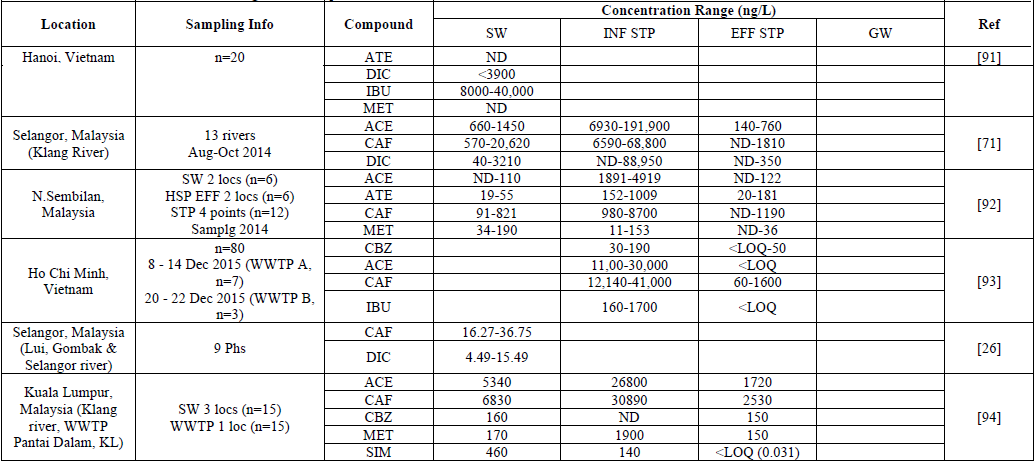
Pharmaceuticals in surface water
Analgesic/ Non-steroidal anti-inflammatory drugs (NSAIDs)
ACE, ASA, DIC and IBU have been detected in SEA’s surface water at varied concentrations. These pharmaceuticals have been found ubiquitously not only in SEA but worldwide, due to their widespread use as over-the-counter (OTC) medicine, low price and effective medicine as pain relievers [66].
The concentration of ACE in surface water in SEA ranges between 4 to 1,450 ng/L. Subari et al. has reported the highest concentration of ACE (1,450 ng/L) in Malaysian rivers [71]. A comparable concentration has been reported by Tran et al. in Singapore (1163 ng/L). Ma et al. so far reported highest concentration of ACE in Beiyun River Basin, China (3,577 ng/L) [81]. The amount of ACE obtained was relatively very low in some other countries; i.e. 32 ng/L in a Japanese river [ 52] and 69.15 ng/L in a Portuguese river [95].
The concentration of ASA (also known as aspirin) in SEA has only been reported by Tewari et al. in Chao Phraya River, Thailand with a maximum concentration of 7,520 ng/L. Agunbiade and Moodley reported the highest concentration of ASA ranging from 13,708 to 25,345 ng/L in Msunduzi River, South Africa [68].
DIC has been observed in the concentration range of 1.5-3,900 ng/L in SEA surface water. The highest concentration of DIC (3,900 ng/L) in SEA has been recorded by Le et al. in Hanoi, Vietnam [91]. A relatively significant concentration of DIC (3,210 ng/L) was also observed by Subari et al. [71]. Higher concentrations so far have been reported with a concentration of 8,174 ng/L by Agunbiade and Moodley [68]. A much lower concentration of DIC in surface water has been reported with values smaller than 100 ng/L by Paiga et al. (38 ng/L) [96], Pereira et al. (58 ng/L) [95], Brieudes et al. (30 ng/L) [97].
IBU has been reported in a wide range of concentrations, from 2 to 40,000 ng/L in surface water of SEA. This highest amount of IBU has been reported by Le et al. in Hanoi, Vietnam [91]. Agunbiade and Moodley reported very high concentration of IBU among others in the world (689,000 ng/L) in a South African river [68]. Other countries in SEA reported much lower concentrations, ranging from 76 ng/L to 111 ng/L [29,85]. These amounts are similar to those found in most of the developed countries i.e. 62 ng/L [98] and 116 ng/L [82].
Antidiabetic
Two antidiabetics in this study, GLI and MEF, have been investigated in Malaysian rivers, the only report among SEA countries. In Malaysia, GLI and MEF have been listed among the top 5 drugs consumed as antidiabetic medication [49].
The presence of GLI has been reported by Al-Odaini et al. and Al-Qaim et al. in Malaysian rivers with maximum amounts of 19.7 ng/L and 36 ng/L, respectively [27,99]. A comparable amount of GLI (53.9 ng/L) has been reported by Archer et al. in South Africa [51].
Meanwhile, MEF has also been reported by Al-Odaini et al. with a maximum concentration of 189.6 ng/L [27] and this amount is comparable with the concentration reported by Asghar et al. i.e. 121.4 ng/L [62], Wood et al. i.e. 179 ng/L [100] and Archer et al. i.e. 174.6 ng/L [51]. The highest amount of MEF was detected in Colorado, USA with a maximum concentration of 7,130 ng/L [101].
Antihistamine
The three antihistamines studied were CET, CHL and RAN. However, these pharmaceuticals have not been widely studied in the aquatic environment. The presence of RAN and CET in SEA’s surface water has not been investigated yet.
CHL has been reported as not being detected in SEA’s surface water probably due to its high hydrophobicity (Log Kow =3.38) that possibly led to less partitioning in aqueous phase [27]. In South Africa, Wood et al. reported that the presence of CHL was < LOQ (1.1 pg) [100], while Mandaric et al. reported the presence of RAN <LOQ (0.3 ng/L) in Italian river [82].
Antihypertensives
Four antihypertensive drugs, namely AML, ATE, MET and PRA were investigated in SEA’s surface water. AML has only been investigated by Al-Odaini et al. with concentration lower than MDL in all samples in a Malaysian river [27].
ATE has been detected within 9-101 ng/L in SEA with the highest amount reported by Tewari et al. and in agreement with Al-Odaini et al. i.e. 86.6 ng/L [27,50]. A comparable amount of ATE, i.e. 272 ng/L has been reported by Archer et al. in a South African river [51].
MET has been quantified in SEA’s surface water with equivalent concentrations reported by Al-Odaini et al. and Al-Qaim et al. of 190 ng/L [27,92] and Tahrim et al. (170 ng/L) [94]. Higher concentrations of MET have been detected in USA and China, with concentrations of approximately 500 ng/L [81,101].
PRA has only been investigated in Malaysian rivers among SEA countries, observing a maximum concentration of 30 ng/L found by Al-Qaim et al. [6].
Lipid regulator
A maximum amount of SIM i.e. 460 ng/L has been detected in a Malaysian river by Tahrim et al. [94]. This amount contrasts with previous levels found by Al-Odaini et al. and Al-Qaim et al. i.e. not detected and 6 ng/L, respectively [6, 27]. Pereira et al. also reported SIM as not detected in a Portuguese river [95].
Anti-convulsant
CBZ has been reported with concentrations ranging from 0.5 to 670 ng/L in SEA’s surface water, with the highest amount observed in a Vietnamese river [86]. This amount is considered high compared to those reported in other countries. Comparable amounts of CBZ have been detected in low concentrations, less than 200 ng/L, in Malaysia [94], Japan [4], China [81] and Italy [82].
Bronchodilator
The highest concentration of SAL, i.e. 19.1 ng/L in surface water in SEA has been detected by Sakai et al. [90]. This amount is comparable with that reported by Al- Odaini et al., both in Malaysian rivers [27]. Asghar et al. reported a slightly higher amount of SAL at 35 ng/L in China [62].
Stimulant
CAF has been detected abundantly in SEA’s surface water, with a maximum amount reported as 20,620 ng/L in a Malaysian river [71]. A comparable high amount of CAF was also reported by Tran et al. in Singapore and Dsikowitzky et al. in Indonesia, with concentrations of 14,418 ng/L and 8,900 ng/L, respectively [29,89]. CAF has been found ubiquitously in surface water due to its direct discharge from beverages into nearby drain/ river besides from STP. A relatively low concentration of CAF; i.e. below 500 ng/L has been reported by Tan et al. (269 ng/L), Praveena et al. (37 ng/L), Azuma et al. (166 ng/L) and Asghar et al. (220 ng/L) [26,52,62,88].
Pharmaceuticals in Influent of Sewage Treatment Plants (STPs)
Analgesic/ Non-steroidal anti-inflammatory drugs (NSAIDs)
The analgesics/NSAIDs ACE, ASA, DIC and IBU have been detected in raw domestic STP (influent) in SEA at various concentrations. The concentration of ACE showed a wide range between 67-337,035 ng/L with the maximum amount reported by Tran et al. in Singapore [29]. The concentration is in agreement with data reported by Subari et al. and Petrie et al. of 191,900 ng/L and 138,164 ng/L in Malaysian and English rivers, respectively [34,71]. Paiga et al. reported the highest amount of ACE around the world i.e. 615,135 ng/L in STP’s influent in Portugal [96].
ASA has been detected in raw STP in SEA, reaching a maximum concentration of 16,000 ng/L in Thailand [50]. A higher concentration of ASA i.e. 118,000 ng/L was detected in Msunduzi River, South Africa by Agunbiade and Moodley [68].
Wide variation in concentration of DIC has been observed in SEA’s STP influent with a concentration range from 32 to 88,950 ng/L with the highest amount recorded by Subari et al. in Malaysia [71]. High concentration of DIC (22,300 ng/L) has also been reported in South Africa [68].
IBU has been reported with the maximum amount of 2,445 ng/L by Tran et al. in Singapore [29], which is in agreement with values reported for SEA’s STP influent in Thailand [50] and in Vietnam [93] with concentrations of 1,260 ng/L and 1,700 ng/L, respectively. Paiga et al. reported a higher amount of IBU i.e. 24,505 ng/L in STP influent in Portugal [96] which is comparable with the concentration of 17,341 ng/L reported by Azuma et al. in Japan [52]. Relatively low concentrations (< 2000 ng/L) of IBU have been detected in STP influent in Thailand (1,260 ng/L), Vietnam (1,760 ng/L) and South Africa (1,380 ng/L) [50, 68, 93].
Antidiabetic
GLI in STP influent in SEA has been investigated in Malaysia with a concentration of 130 ng/L [6]. Lower concentrations of GLI have been reported by Al-Qaim et al. and Petrie et al. as 34.5 ng/L and 60 ng/L, respectively [34, 102].
MEF has not been investigated yet in SEA’s STP influent. High amount of MEF has been found in STP influent in South -West England and Saudi Arabia, with concentrations of 44,204 ng/L and 31,200 ng/L, respectively [ 34, 35]. Kosma et al. reported a slightly lower amount of MEF i.e. 1167 ng/L in raw STP water in Greece [103].
Antihistamine
The presence of CET, CHL and RAN in STP’s influent in SEA has not been investigated yet. CHL has been investigated by Shraim et al. and was not detected in STP influent in Madinah [35]. Petrie et al. reported the presence of CET in South-West England STP’s influent with a high concentration of 1,571 ng/L [34], and this is comparable with the concentration reported by Papageorgiou et al. i.e. 816 ng/L in Volos, Greece [104]. RAN has been found in STP influent by Petrie et al. at a concentration of 781 ng/L [34].
Antihypertensive
AML has not been investigated yet in STP’s influent in SEA. The maximum amount of ATE in SEA’s STP influent has been reported by Al-Qaim et al. at a concentration of 1,009 ng/L [92]. A much higher concentration of ATE was found in STP influent in the USA i.e. 14,000 ng/L by Anumol and Snyder [72]. Anumol et al. also reported a high amount of ATE in STP influent in Chennai, India, at a concentration of 6,900 ng/L [7]. These amounts are comparable with those reported by Shraim et al. and Petrie et al., i.e. 4,030 ng/L and 1,689 ng/L, respectively [34, 35].
In SEA, MET has been only investigated in Malaysian STP influent, with the highest amount quantified by Tahrim et al. at 1,900 ng/L [94]. A moderate high concentration of MET has been recorded by Tan et al., i.e. 959 ng/L [88]. It is in agreement with the concentration reported by Papageorgiou et al. (474 ng/L) in a STP influent in Greece [104]. A much lower concentration of MET; i.e < 200 ng/L has been found in a STP influent by Petrie et al. and Al-Qaim et al. at concentrations of 37.0 ng/L and 153 ng/L, respectively [34, 92].
The only reported amount of PRA in SEA’s STP influent has been reported by Al-Qaim et al. at a concentration of 525 ng/L [6].
Lipid regulator
SIM has been detected in a Malaysian STP influent with low concentration i.e. 37 ng/L [6]. Meanwhile a high concentration of SIM has been observed by Papageorgiou et al. with a concentration of 718 ng/L in a STP influent in Greece [104].
Anti-convulsant
CBZ has been reported with a maximum concentration of 939 ng/L in SEA’s STP influent [29] and is comparable with the value 920 ng/L recorded by Anumol et al. in India [7]. Very high concentration of CBZ (4,524 ng/L) has been measured by Morosini et al. in STP influents in Northern Italy [105]. This value is also in agreement with the concentration reported by Al-Tarawneh et al. i.e. 3600 ng/L in Jordan [106]. Lower concentrations of CBZ (< 200 ng/L) in STP influents have been reported in Japan (137 ng/L) [52], Greece (114 ng/L) [104] and Vietnam (190 ng/) [93].
Bronchodilator
SAL has not been investigated yet in any SEA’s STP influent. Low concentration of SAL has been reported by Morosini et al. with a concentration of 8.95 ng/L in Italy [105].
Stimulant
The highest amount of CAF has been reported in SEA STP influents in Singapore with a maximum concentration of 359,400 ng/L [29]. Subari et al., Nguyen et al., Tahrim et al. and Tan et al. also reported high concentrations of CAF in SEA’s STP influents with a concentration of 68,800 ng/L, 41,000 ng/L, 30,890 ng/L and 26,499 ng/L, respectively [71, 88, 93, 94]. This amount is also comparable with those reported by Anumol and Snyder (85,000 ng/L) [72], Petrie et al. (74,813 ng/L) [34] and Anumol et al. (65,000 ng/L) [7].
Pharmaceuticals in effluent of Sewage Treatment Plants (STPs)
Analgesic/ Non-steroidal anti-inflammatory drugs (NSAIDs)
The maximum concentration of ACE recorded in SEA’s STP effluents was 2211 ng/L [27]. This amount is in agreement with the that reported by Tahrim et al. i.e. 1,720 ng/L [94] and Petrie et al. (1,454 ng/L) [34]. Tewari et al. and Subari et al. obtained a comparable amount of ACE in SEA with a moderate concentration of 734 ng/L and 760 ng/L, respectively [50, 71]. Low amounts of ACE (<200 ng/L) have been reported by Tan et al. and Al-Qaim et al. both in Malaysian STP effluents [88, 92]. Shraim et al. reported the highest amount of ACE (90,500 ng/L) in the world in a STP effluent in Madinah [35]. A very low amount of ACE i.e. 39 ng/L was detected in a Japanese river [52].
ASA only has been observed in STP’s effluents in SEA by Tewari et al. in Thailand, with a maximum concentration reported of 553 ng/L [50]. A very high amount of ASA, i.e. 47,100 ng/L has been reported by Agunbiade and Moodley in STP effluent in South Africa [68].
DIC has been detected in STP effluents in SEA, reaching a maximum concentration of 650 ng/L in Malaysia [88]. The concentration of DIC in SEA’s STP effluents was quite low compared to those reported in other countries. A comparable amount of DIC has been detected in other countries, i.e. 724 ng/L and 436 ng/L in Portugal and the UK, respectively [34, 96]. Agunbiade and Moodley reported a high amount of DIC in South Africa with a concentration of 19,000 ng/L [68]. A moderate amount of DIC has been reported by Papageorgiou et al. (2,668 ng/L) [104], Anumol and Snyder (1,800 ng/L) [72], Becerra-Herrera et al. (1,390 ng/L) [107] and Al-Tarawneh et al. (1,100 ng/L) [106].
IBU has been detected in relatively low concentrations in STP effluents in SEA, with a maximum amount of 149 ng/L [50]. Higher concentrations of IBU have been reported by Paiga et al. with a maximum value of 3,304 ng/L [96], in agreement with levels reported by Al-Tarawneh et al. (2200 ng/L) [106], Azuma et al. (1,763 ng/L) [52] and Agunbiade and Moodley (1,380 ng/L) [68].
Antidiabetic
The presence of GLI has been reported with relatively low concentrations in STP effluents in SEA with a maximum concentration of 162 ng/L [27]. Very low amount of GLI was also recorded by Al-Qaim et al. and Petrie et al. with concentrations of 70 ng/L and 30 ng/L, respectively [6, 34].
Huge amounts of MEF have been detected in STP effluents in SEA by Al-Odaini et al. with a maximum concentration of 34,228 ng/L [27]. Other countries also reported a relatively high amount of MEF in STP effluents in the UK, Australia and Madinah, i.e. 19,784 ng/L [34], 9,080 ng/L [36], 5,510 ng/L [35] respectively. In contrast, Kosma et al. found very low levels of MEF in Greece i.e. 26 ng/L [103].
Antihistamine
The presence of CET and RAN in STP’s effluents in SEA has not been investigated yet. CET has been reported with a comparable amount of 1,961 ng/L [34], 1,238 ng/L [104] and 1,130 ng/L [36], respectively. Petrie et al. also reported the presence of RAN in UK STP’s effluents with a concentration of 475 ng/L [34]. CHL has been investigated by Al-Odaini et al.; however, it has not been detected in SEA’s STP effluents [27].
Antihypertensive
AML has been detected in STP’s effluents in SEA with a maximum concentration of 16.9 ng/L [27]. The maximum amount of ATE in SEA’s STP effluents has been found by Al-Odaini et al. with a concentration of 1,491 ng/L [27]. This amount is in agreement with the concentration reported by Shraim et al. (2,010 ng/L) in Madinah [35], Anumol et al. (1,600 ng/L) in India [7] and Papageorgiou et al. in Greece (1,707 ng/L) [104].
A low concentration of ATE has been detected in STP effluents in SEA i.e. 62.5 ng/L and 32 ng/L, respectively by Tewari et al. and Tan et al [50, 88]. Morosini et al., Petrie et al. and Anumol and Snyder reported a comparable amount of ATE in the range of 600-700 ng/L in STP’s effluents [34, 72, 105].
The presence of MET in STP’s effluents in SEA has been detected by Al-Odaini et al. reaching the maximum amount of 1,612 ng/L [27]. On the contrary, a low concentration of MET has been reported (< 200 ng/L) by Tan et al. (189 ng/L) [88], Tahrim et al. (150 ng/L) [94] and Al-Qaim et al. (36 ng/L) [92]. Papageorgiou et al. found 780 ng/L of MET in STP’s effluents in Italy [104].
PRA has only been quantified in Malaysia in SEA’s STP effluents with a maximum value of 116 ng/L [6].
Lipid regulator
Very low concentration of SIM has been obtained in STP effluents in SEA i.e. 22 ng/L by Al-Qaim et al. [6] while Al-Odaini et al. reported as not detected [27]. Meanwhile, Papageorgiou et al. reported high concentrations of SIM in STP effluents in Volos, Greece at a maximum concentration of 1,738 ng/L [104].
Anti-convulsant
A maximum concentration of CBZ in STP’s effluents has been detected by Al-Qaim et al. i.e. 344 ng/L [6]. The amount of CBZ reported is similar to other studies by Anumol and Snyder, Petrie et al. and Paiga et al. with concentrations of 340 ng/L, 316 ng/L and 245 ng/L, respectively [34, 72, 96]. However, a much higher concentration of CBZ has been found in STP’s effluents in Italy and Jordan i.e. 5,721 ng/L and 1,300 ng/L [105, 106].
Bronchodilator
A low concentration of SAL (27.7 ng/L) has been detected in STP effluents in SEA [27]. This amount of SAL is comparable with the concentration reported by Morosini et al., i.e. 10 ng/L [105].
Stimulant
CAF has been well investigated in STP effluents in SEA, with a maximum amount recorded as 2,530 ng/L [94]. This amount is in agreement with Subari et al. (1,810 ng/L) [71], Tewari et al. (1,720 ng/L) [50], Nguyen et al. (1,600 ng/L) [93], Al-Qaim et al. (1,464 ng/L and 1,190 ng/L) [6, 92] in SEA. Higher concentrations of CAF in STP effluents have been observed by Petrie et al. and Anumol et al., with levels of 5,991 ng/L and 5,400 ng/L, respectively [7, 34]. Low concentrations of CAF; i.e. below 150 ng/L have been reported at 122 ng/L [88] and 124 ng/L [52].
Conclusion
To the authors’ knowledge, this review paper depicts the research done until now regarding emerging contaminants of pharmaceuticals in SEA’s water bodies, specifically for Malaysia. The information on targeted compounds reported here is valuable for research into the occurrence and distribution of pharmaceuticals in SEA aquatic environment. Although studies on the presence of pharmaceuticals in SEA’s water bodies are increasing, only certain countries in SEA have taken part in doing this research. The successful measurement of pharmaceuticals requires enhancement of analytical facilities, technical capabilities and resources. There are no national databases that provide inventories and assessments of environmental distributions of pharmaceuticals in SEA. The coordination of these activities in determining individual interests in evaluating pharmaceutical compounds will be a first step for all countries in the region, followed by the evaluation of individual capabilities and resources to be able to accomplish pharmaceuticals measurements. A large variety of other topics need to be addressed, such as metabolites, transformation products, the presence of chemical pathogens in environmental waters and correlation of these levels of micro-pollutants with potential sub lethal toxicological endpoints for risk assessment. Future research should be expanded geographically within SEA countries and include various type of water matrices and sediment in aquatic environment, especially in drinking water, and cover different sources of pollution. Understanding of the occurrence and distribution of complex organic contaminants will help predict and mitigate their potential effects on ecological and human health in aquatic environments, allowing data usage for toxicological assessments and comparisons to move forward on a regional basis. Future studies will provide significant information for authorities to set up guidelines and regulations along with proper implications.
Acknowledgements
The authors acknowledge support from this work by the JPA, Government of Malaysia, National Hydraulic Research Institute of Malaysia (NAHRIM), Ministry of Environment and Water and Malaysia Japan International Institute of Technology, University Technology Malaysia in the form of scholarship and research grant. Special thanks also to Mrs. Nida Hidayati Ghazali and Ms. Siti Aisyah Humaira Ghazali for assisting in providing some materials.
References
1. Ternes, T. A. TrAC, Trends Anal. Chem. 2001, 20, 419-434. DOI: https://doi.org/10.1016/S0165-9936(01)00078-4
2. Barbosa, M. O.; Ribeiro, A. R.; Pereira, M. F. R.; Silva, A. M. T. Anal. Bioanal. Chem. 2016, 408, 8355-8367. DOI 10.1007/s00216-016-9952-7.
3. Furlong, E. T.; Batt, A. L.; Glassmeyer, S. T.; Noriega, M. C.; Kolpin, D. W.; Mash, H.; Schenck, K. M. Sci. Total Environ. 2017, 579, 1629-1642. DOI: https://doi.org/10.1016/j.scitotenv.2016.03.128
4. Azuma, T.; Arima, N.; Tsukada, A.; Hirami, S.; Matsuoka, R.; Moriwake, R.; Ishiuchi, H.; Inoyama, T.; Teranishi, Y.; Yamaoka, M.; Ishida, M.; Hisamatsu, K.; Yunoki, A.; Mino, Y. Environ. Sci. Pollut. Res. 2017, 24, 19021-19030. DOI: 10.1007/s11356-017-9525-0.
5. Kong, L.; Kadokami, K.; Wang, S.; Duong, H. T.; Chau, H. T. C. Chemosphere. 2015, 122, 125-130. DOI: https://doi.org/10.1016/j.chemosphere.2014.11.025
6. Al-Qaim, F. F.; Abdullah, M. P.; Othman, M. R.; Mussa, Z. H.; Zakaria, Z.; Latip, J.; Afiq, W. M. J. Braz. Chem. Soc. 2015, 26, 1124-1135. DOI: 10.5935/0103-5053.20150075.
7. Anumol, T.; Vijayanandan, A.; Park, M.; Philip, L.; Snyder, S. A. Environ. Int. 2016, 92-93, 33-42. DOI: https://doi.org/10.1016/j.envint.2016.03.022
8. Archer, E.; Petrie, B.; Kasprzyk-Hordern, B.; Wolfaardt, G. M. Chemosphere. 2017, 174, 437-446. DOI: https://doi.org/10.1016/j.chemosphere.2017.01.101
9. Chonova, T.; Keck, F.; Labanowski, J.; Montuelle, B.; Rimet, F.; Bouchez, ASci. Total Environ . 2016, 542, 965-975. DOI: https://doi.org/10.1016/j.scitotenv.2015.10.161
10. Lindberg, R. H.; Östman, M.; Olofsson, U.; Grabic, R.; Fick, J. Water Res. 2014, 58, 221-229. DOI: https://doi.org/10.1016/j.watres.2014.03.076
11. Kong, L.; Kadokami, K.; Duong, H. T.; Chau, H. T. C. Chemosphere. 2016, 165, 221-230. DOI: https://doi.org/10.1016/j.chemosphere.2016.08.084
12. Mirzaei, R.; Yunesian, M.; Nasseri, S.; Gholami, M.; Jalilzadeh, E.; Shoeibi, S.; Bidshahi, H. S.; Mesdaghinia, A. J. Environ. Health Sci. Eng. 2017, 15, 16. DOI: 10.1186/s40201-017-0282-2.
13. Ali, A. M.; Rønning, H. T.; Alarif, W.; Kallenborn, R.; Al-Lihaibi, S. S. Chemosphere. 2017, 175, 505-513. DOI: https://doi.org/10.1016/j.chemosphere.2017.02.095
14. Borecka, M.; Siedlewicz, G.; Haliński, Ł. P.; Sikora, K.; Pazdro, K.; Stepnowski, P.; Białk-Bielińska, A. Mar. Pollut. Bull. 2015, 94, 62-71. DOI: https://doi.org/10.1016/j.marpolbul.2015.03.008
15. Fantuzzi, G.; Aggazzotti, G.; Righi, E.; Predieri, G.; Castiglioni, S.; Riva, F.; Zuccato, E. Sci. Total Environ . 2018, 635, 956-963. DOI: https://doi.org/10.1016/j.scitotenv.2018.04.155
16. Teo, T. L. L.; Coleman, H. M.; Khan, S. J. Environ. Sci. Pollut. Res . 2016, 23, 6972-6981. DOI: 10.1007/s11356-015-5967-4.
17. Fent, K.; Weston, A. A.; Caminada, D. Aquat. Toxicol. 2006, 76, 122-159. DOI: https://doi.org/10.1016/j.aquatox.2005.09.009
18. You, L.; Nguyen, V. T.; Pal, A.; Chen, H.; He, Y.; Reinhard, M.; Gin, K. Y.-H. Sci. Total Environ . 2015, 536, 955-963 DOI: https://doi.org/10.1016/j.scitotenv.2015.06.041
19. Daughton, C. G.; Ternes, T. A. Environ. Health Perspect. 1999, 107, 907-938. DOI: 10.2307/3434573.
20. Richardson, B. J.; Lam, P. K. S.; Martin, M. Mar. Pollut. Bull . 2005, 50, 913-920. DOI: https://doi.org/10.1016/j.marpolbul.2005.06.034
21. Gröner, F.; Höhne, C.; Kleiner, W.; Kloas, W. Chemosphere. 2017, 166, 473-481. DOI: https://doi.org/10.1016/j.chemosphere.2016.09.116
22. Niemuth, N. J.; Klaper, R. D. Chemosphere. 2015, 135, 38-45. DOI: https://doi.org/10.1016/j.chemosphere.2015.03.060
23. Organization, W. H. Pharmaceuticals in drinking-water; 9791156217343; World Health Organization: 2012.
24. Ternes, T. A. Water Res . 1998, 32, 3245-3260. DOI: https://doi.org/10.1016/S0043-1354(98)00099-2
25. Paiga, P.; Santos, L.; Amorim, C. G.; Araujo, A. N.; Montenegro, M.; Pena, A.; Delerue-Matos, C.. Environ. Sci. Pollut. Res . 2013, 20, 2410-2420. DOI: 10.1007/s11356-012-1128-1.
26. Praveena, S. M.; Shaifuddin, S. N. M.; Sukiman, S.; Nasir, F. A. M.; Hanafi, Z.; Kamarudin, N.; Ismail, T. H. T.; Aris, A. Z. Sci. Total Environ . 2018, 642, 230-240. DOI: https://doi.org/10.1016/j.scitotenv.2018.06.058
27. Al-Odaini, N. A.; Zakaria, M. P.; Yaziz, M. I.; Surif, S.; Abdulghani, M. Int. J. Environ. Anal. Chem. 2013, 93, 245-264. DOI: 10.1080/03067319.2011.592949.
28. Bayen, S.; Zhang, H.; Desai, M. M.; Ooi, S. K.; Kelly, B. C. Environ. Pollut. 2013, 182, 1-8. DOI: https://doi.org/10.1016/j.envpol.2013.06.028
29. Tran, N. H.; Hu, J.; Ong, S. L. Talanta. 2013, 113, 82-92. DOI: https://doi.org/10.1016/j.talanta.2013.03.072
30. Bade, R.; Rousis, N. I.; Bijlsma, L.; Gracia-Lor, E.; Castiglioni, S.; Sancho, J. V.; Hernandez, F. Anal. Bioanal. Chem . 2015, 407, 8979-8988. DOI: 10.1007/s00216-015-9063-x.
31. Mirasole, C.; Di Carro, M.; Tanwar, S.; Magi, E. J. Mass Spectrom. 2016, 51, 814-820. DOI: 10.1002/jms.3813.
32. Fairbairn, D. J.; Karpuzcu, M. E.; Arnold, W. A.; Barber, B. L.; Kaufenberg, E. F.; Koskinen, W. C.; Novak, P. J.; Rice, P. J.; Swackhamer, D. L. Sci. Total Environ . 2016, 551-552, 605-613. DOI: https://doi.org/10.1016/j.scitotenv.2016.02.056
33. Manamsa, K.; Crane, E.; Stuart, M.; Talbot, J.; Lapworth, D.; Hart, A. Sci. Total Environ . 2016, 568, 712-726. DOI: https://doi.org/10.1016/j.scitotenv.2016.03.017
34. Petrie, B.; Youdan, J.; Barden, R.;Kasprzyk-Hordern, B. J. Chromtogr. A. 2016, 1431, 64-78. DOI: https://doi.org/10.1016/j.chroma.2015.12.036
35. Shraim, A.; Diab, A.; Alsuhaimi, A.; Niazy, E.; Metwally, M.; Amad, M.; Sioud, S.; Dawoud, A. Arabian J. Chem. 2017, 10, S719-S729. DOI: https://doi.org/10.1016/j.arabjc.2012.11.014
36. Althakafy, J. T.; Kulsing, C.; Grace, M. R.; Marriott, P. J. J. Chromatogr. A. 2017, 1515, 164-171. DOI: https://doi.org/10.1016/j.chroma.2017.08.003
37. Roberts, J.; Kumar, A.; Du, J.; Hepplewhite, C.; Ellis, D. J.; Christy, A. G.; Beavis, S. G. Sci. Total Environ . 2016, 541, 1625-1637. DOI: https://doi.org/10.1016/j.scitotenv.2015.03.145
38. Dai, G.; Wang, B.; Huang, J.; Dong, R.; Deng, S.; Yu, G. Chemosphere . 2015, 119, 1033-1039. DOI: https://doi.org/10.1016/j.chemosphere.2014.08.056
39. Wang, Z.; Du, Y.; Yang, C.; Liu, X.; Zhang, J.; Li, E.; Zhang, Q.; Wang, X. Sci. Total Environ . 2017, 609, 1423-1432. DOI: https://doi.org/10.1016/j.scitotenv.2017.08.009
40. Archana, G.; Dhodapkar, R.; Kumar, A. Environ. Monit. Assess. 2016, 188, 10. DOI: 10.1007/s10661-016-5510-1.
41. Mohapatra, S.; Huang, C.-H.; Mukherji, S.; Padhye, L. P. Chemosphere . 2016, 159, 526-535. DOI: https://doi.org/10.1016/j.chemosphere.2016.06.047
42. Chau, H. T. C.; Kadokami, K.; Ifuku, T.; Yoshida, Y. Environ. Sci. Pollut. Res . 2017, 24, 26396-26409. DOI: 10.1007/s11356-017-9929-x.
43. Hanamoto, S.; Nakada, N.; Yamashita, N.; Tanaka, H. Sci. Total Environ . 2018, 615, 964-971, DOI https://doi.org/10.1016/j.scitotenv.2017.10.013
44. Choi, K.; Kim, Y.; Park, J.; Park, C. K.; Kim, M.; Kim, H. S.; Kim, P. Sci. Total Environ . 2008, 405 , 120-128. DOI: https://doi.org/10.1016/j.scitotenv.2008.06.038
45. Kim, J. W.; Jang, H. S.; Kim, J. G.; Ishibashi, H.; Hirano, M.; Nasu, K.; Ichikawa, N.; Takao, Y.; Shinohara, R.; Arizono, K. J. Health Sci. 2009, 55, 249-258. DOI: 10.1248/jhs.55.249.
46. Managaki, S.; Murata, A.; Takada, H.; Tuyen, B. C.; Chiem, N. H. Environ. Sci. Technol. 2007, 41, 8004-8010. DOI: 10.1021/es0709021.
47. Praveena, S. M.; Lui, T. S.; Hamin, N.; Raza, S.; Aris, A. Z. Environ. Monit. Assess . 2016, 188, 11. DOI: 10.1007/s10661-016-5438-5.
48. Yien Fang, T.; Praveena, S. M.; Aris, A. Z.; Syed Ismail, S. N.; Rasdi, I. Chemosphere . 2019, 215, 153-162. DOI: https://doi.org/10.1016/j.chemosphere.2018.10.032
49. Ministry of Health Malaysia Malaysian Statistics on Medicines (MSOM) 2011-2014; Ministry of Health Malaysia: Pharmaceutical Services Division, 2017.
50. Tewari, S.; Jindal, R.; Kho, Y. L.; Eo, S.; Choi, K. Chemosphere . 2013, 91, 697-704. DOI: https://doi.org/10.1016/j.chemosphere.2012.12.042
51. Archer, E.; Wolfaardt, G. M.; van Wyk, J. H. Water Sa 2017, 43, 684-706. DOI: 10.4314/wsa.v43i4.16.
52. Azuma, T.; Arima, N.; Tsukada, A.; Hirami, S.; Matsuoka, R.; Moriwake, R.; Ishiuchi, H.; Inoyama, T.; Teranishi, Y.; Yamaoka, M.; Mino, Y.; Hayashi, T.; Fujita, Y.; Masada, M. Sci. Total Environ . 2016, 548-549, 189-197. DOI: https://doi.org/10.1016/j.scitotenv.2015.12.157
53. Cai, M. Q.; Wang, R.; Feng, L.; Zhang, L. Q. Environ. Sci. Pollut. Res . 2015, 22, 1854-1867. DOI: 10.1007/s11356-014-3473-8.
54. Ministry of Health Malaysia Malaysian Statistics on Medicines (MSOM) 2004; Ministry of Health Malaysia: Pharmaceutical Services Division , 2006.
55. Ministry of Health Malaysia Malaysian Statistics on Medicines (MSOM) 2005; Ministry of Health Malaysia: Pharmaceutical Services Division , 2007.
56. Ministry of Health Malaysia Malaysian Statistics on Medicines (MSOM) 2006; Ministry of Health Malaysia: Pharmaceutical Services Division , 2009.
57. Ministry of Health Malaysia Malaysian Statistics on Medicines (MSOM) 2008; Ministry of Health Malaysia: Pharmaceutical Services Division , 2013.
58. Ministry of Health Malaysia Malaysian Statistics on Medicines (MSOM) 2009 & 2010; Ministry of Health Malaysia: Pharmaceutical Services Division , 2014.
59. Wells, M. J. Principles of extraction and the extraction of semivolatile organics from liquids. In Sample Preparation Techniques in Analytical Chemistry, John Wiley & Sons, Inc.: NEW YORK, 2003, 37-138.ISBN 0069-2883
60. Gracia-Lor, E.; Sancho, J. V.; Hernández, F. J. Chromatogr. A. 2011, 1218, 2264-2275. DOI: https://doi.org/10.1016/j.chroma.2011.02.026
61. Al-Odaini, N. A.; Zakaria, M. P.; Yaziz, M. I.; Surif, S. J. Chromatogr. A. 2010, 1217, 6791-6806. DOI: https://doi.org/10.1016/j.chroma.2010.08.033
62. Asghar, M. A.; Zhu, Q.; Sun, S.; Peng, Y. e.; Shuai, Q. Sci. Total Environ . 2018, 635, 828-837. DOI: https://doi.org/10.1016/j.scitotenv.2018.04.179
63. Berrueta, L. A.; Gallo, B.; Vicente, F. A Chromatographia. 1995, 40, 474-483. DOI: 10.1007/bf02269916.
64. Lundanes, E.; Reubsaet, L.; Greibrokk, T. Chromatography: basic principles, sample preparations and related methods. John Wiley & Sons, 2013; ISBN 3527675221
65. Ardrey, R. E. Liquid chromatography-mass spectrometry: an introduction. John Wiley & Sons, 2003; Vol. 2, ISBN 0471498017
66. Marsik, P.; Rezek, J.; Židková, M.; Kramulová, B.; Tauchen, J.; Vaněk, T. Chemosphere . 2017, 171, 97-105. DOI: https://doi.org/10.1016/j.chemosphere.2016.12.055
67. Migowska, N.; Caban, M.; Stepnowski, P.; Kumirska, J. Sci. Total Environ . 2012, 441, 77-88. DOI: https://doi.org/10.1016/j.scitotenv.2012.09.043
68. Agunbiade, F. O.; Moodley, B. Environ. Toxicol. Chem. 2016, 35, 36-46. DOI: 10.1002/etc.3144.
69. Benito-Peña, E.; Partal-Rodera, A. I.; León-González, M. E.; Moreno-Bondi, M. C. Anal. Chim. Acta. 2006, 556, 415-422. DOI: https://doi.org/10.1016/j.aca.2005.09.054
70. Moret, S.; Hidalgo, M.; Sanchez, J. M. ISRN Chromatogr. 2012, 2012.
71. Subari, S. N. M.; Osman, R.; Saim, N. Pertanika J. Sci. Technol. 2017, 25, 119-128.
72. Anumol, T.; Snyder, S. A. Talanta. 2015, 132, 77-86. DOI: https://doi.org/10.1016/j.talanta.2014.08.011
73. Cahill, J. D.; Furlong, E. T.; Burkhardt, M. R.; Kolpin, D.; Anderson, L. G. J. Chromatogr. A. 2004, 1041, 171-180. DOI: https://doi.org/10.1016/j.chroma.2004.04.005
74. Castiglioni, S.; Bagnati, R.; Calamari, D.; Fanelli, R.; Zuccato, E. J. Chromatogr. A. 2005, 1092, 206-215. DOI: https://doi.org/10.1016/j.chroma.2005.07.012
75. Petrović, M.; Hernando, M. D.; Díaz-Cruz, M. S.; Barceló, D. J. Chromatogr. A. 2005, 1067, 1-14. DOI: https://doi.org/10.1016/j.chroma.2004.10.110
76. Open Data Drug and Target Database (DRUGBANK). Available online: https://www.drugbank.ca. accessed on 6 August 2018.
77. Toxicology data network (TOXNET). Available online: https://toxnet.nlm.nih.gov accessed on 15 January 2006.
78. Trenholm, R. A.; Vanderford, B. J.; Snyder, S. A. Talanta 2009, 79, 1425-1432. DOI: https://doi.org/10.1016/j.talanta.2009.06.006
79. Al-Qaim, F. F.; Abdullah, M. P.; Othman, M. R.; Latip, J.; Zakaria, Z. J. Chromatogr. A. 2014, 1345, 139-153. DOI https://doi.org/10.1016/j.chroma.2014.04.025
80. Sun, J.; Luo, Q.; Wang, D.; Wang, Z. Ecotoxicol. Environ. Saf. 2015, 117, 132-140. DOI: https://doi.org/10.1016/j.ecoenv.2015.03.032
81. Ma, R.; Wang, B.; Yin, L.; Zhang, Y.; Deng, S.; Huang, J.; Wang, Y.; Yu, G. J. Hazard. Mater. 2017, 323, 147-155. DOI: https://doi.org/10.1016/j.jhazmat.2016.05.030
82. Mandaric, L.; Diamantini, E.; Stella, E.; Cano-Paoli, K.; Valle-Sistac, J.; Molins-Delgado, D.; Bellin, A.; Chiogna, G.; Majone, B.; Diaz-Cruz, M. S.; Sabater, S.; Barcelo, D.; Petrovic, M. Sci. Total Environ . 2017, 590-591, 484-494. DOI: https://doi.org/10.1016/j.scitotenv.2017.02.185
83. Paíga, P.; Santos, L. H. M. L. M.; Delerue-Matos, C. J. Pharm. Biomed. Anal. 2017, 135, 75-86. DOI: https://doi.org/10.1016/j.jpba.2016.12.013
84. Peng, F.-J.; Pan, C.-G.; Zhang, M.; Zhang, N.-S.; Windfeld, R.; Salvito, D.; Selck, H.; Van den Brink, P. J.; Ying, G.-G. Sci. Total Environ . 2017, 589, 46-55. DOI: https://doi.org/10.1016/j.scitotenv.2017.02.200
85. Xu, Y.; Luo, F.; Pal, A.; Gin, K. Y.-H.; Reinhard, M. Chemosphere . 2011, 83, 963-969. DOI: https://doi.org/10.1016/j.chemosphere.2011.02.029
86. Tran, N. H.; Urase, T.; Ta, T. T. Clean-Soil Air Water. 2014, 42, 267-275. DOI: 10.1002/clen.201300021.
87. Duong, H. T.; Kadokami, K.; Chau, H. T. C.; Nguyen, T. Q.; Nguyen, T. T.; Kong, L. X. Environ. Sci. Pollut. Res . 2015, 22, 19835-19847. DOI: 10.1007/s11356-015-5180-5.
88. Tan, E. S. S.; Bin Ho, Y.; Zakaria, M. P.; Latif, P. A.; Saari, N. Int. J. Environ. Anal. Chem . 2015, 95, 816-832. DOI: 10.1080/03067319.2015.1058929.
89. Dsikowitzky, L.; Sträter, M.; Dwiyitno; Ariyani, F.; Irianto, H. E.; Schwarzbauer, J. Mar. Pollut. Bull . 2016, 110, 654-664. DOI: https://doi.org/10.1016/j.marpolbul.2016.02.019
90. Sakai, N.; Mohd Yusof, R.; Sapar, M.; Yoneda, M.; Ali Mohd, M. Sci. Total Environ . 2016, 548-549, 43-50. DOI: https://doi.org/10.1016/j.scitotenv.2016.01.040
91. Le, M. D.; Duong, H. A.; Nguyen, M. H.; Sáiz, J.; Pham, H. V.; Mai, T. D. Talanta. 2016, 160, 512-520. DOI: https://doi.org/10.1016/j.talanta.2016.07.032
92. Al-Qaim, F. F.; Mussa, Z. H.; Yuzir, A.; Abu Tahrim, N.; Hashim, N.; Azman, S. Water. 2018, 10, 16. DOI: 10.3390/w10070916.
93. Nguyen, H. T.; Thai, P. K.; Kaserzon, S. L.; O'Brien, J. W.; Eaglesham, G.; Mueller, J. F. Assessment of drugs and personal care products biomarkers in the influent and effluent of two wastewater treatment plants in Ho Chi Minh City, Vietnam. Science of The Total Environment 2018, 631-632, 469-475, DOI https://doi.org/10.1016/j.scitotenv.2018.02.309.
94. Tahrim, N. A.; Abdullah, M. P.; Aziz, Y. F. A. Sains Malays. 2018, 47, 931-940,
95. Pereira, A. M. P. T.; Silva, L. J. G.; Laranjeiro, C. S. M.; Meisel, L. M.; Lino, C. M.; Pena, A. Sci. Total Environ . 2017, 609, 1182-1191. DOI: https://doi.org/10.1016/j.scitotenv.2017.07.200
96. Paíga, P.; Santos, L. H. M. L. M.; Ramos, S.; Jorge, S.; Silva, J. G.; Delerue-Matos, C. Sci. Total Environ . 2016, 573, 164-177. DOI: https://doi.org/10.1016/j.scitotenv.2016.08.089
97. Brieudes, V.; Lardy-Fontan, S.; Lalere, B.; Vaslin-Reimann, S.; Budzinski, H. Talanta. 2016, 146, 138-147. DOI: https://doi.org/10.1016/j.talanta.2015.06.073
98. Aristizabal-Ciro, C.; Botero-Coy, A. M.; Lopez, F. J.; Penuela, G. A. Environ. Sci. Pollut. Res . 2017, 24, 7335-7347. DOI: 10.1007/s11356-016-8253-1.
99. Al-Qaim, F. F.; Abdullah, M. P.; Othman, M. R.; Latip, J.; Afiq, W. M. Trop. J. Pharm. Res. 2013, 12, 609-616. DOI: 10.4314/tjpr.v12i4.25.
100. Wood, T. P.; Du Preez, C.; Steenkamp, A.; Duvenage, C.; Rohwer, E. R. Environ. Pollut . 2017, 230, 453-462. DOI: https://doi.org/10.1016/j.envpol.2017.06.043
101. Bai, X.; Lutz, A.; Carroll, R.; Keteles, K.; Dahlin, K.;Murphy, M.; Nguyen, D. Chemosphere . 2018, 200, 133-142. DOI: https://doi.org/10.1016/j.chemosphere.2018.02.106
102. Al-Qaim, F. F.; Abdullah, M. P.; Latip, J.; Khalik, W.; Abu Tahrim, N.; Abidin, N. A. Z.; Othman, M. R. Sains Malays. 2016, 45, 803-810.
103. Kosma, C. I.; Lambropoulou, D. A.; Albanis, T. A. Water Res . 2015, 70, 436-448. DOI: https://doi.org/10.1016/j.watres.2014.12.010
104. Papageorgiou, M.; Kosma, C.; Lambropoulou, D. Sci. Total Environ . 2016, 543, 547-569. DOI: https://doi.org/10.1016/j.scitotenv.2015.11.047
105. Morosini, C.; Marsoni, M.; Torretta, V.; Conti, F.; Ragazzi, M.; Rada, E. C.; Cioca, G. Sustainability. 2017, 9, 15. DOI: 10.3390/su9081466.
106. Al-Tarawneh, I.; El-Dosoky, M.; Alawi, M.; Batarseh, M.; Widyasari, A.; Kreuzig, R.; Bahadir, M. Clean-Soil Air Water . 2015, 43, 504-511. DOI: 10.1002/clen.201300920.
107. Becerra-Herrera, M.; Honda, L.; Richter, P. J. Chromatogr. A. 2015, 1423, 96-103. DOI: https://doi.org/10.1016/j.chroma.2015.10.071
Author notes
*Corresponding author: Norbaya Hashim, email: norbaya@nahrim.gov.my
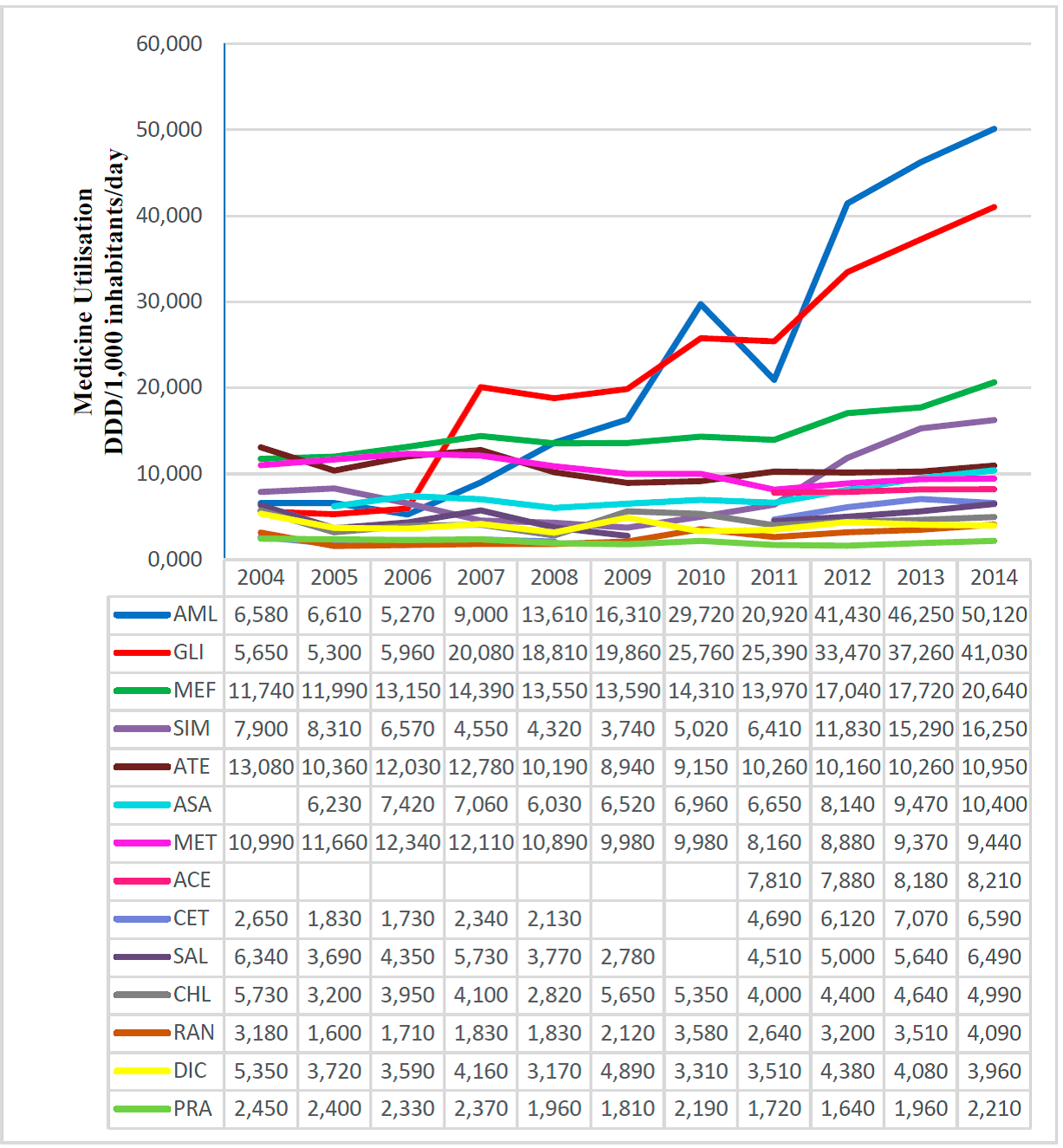
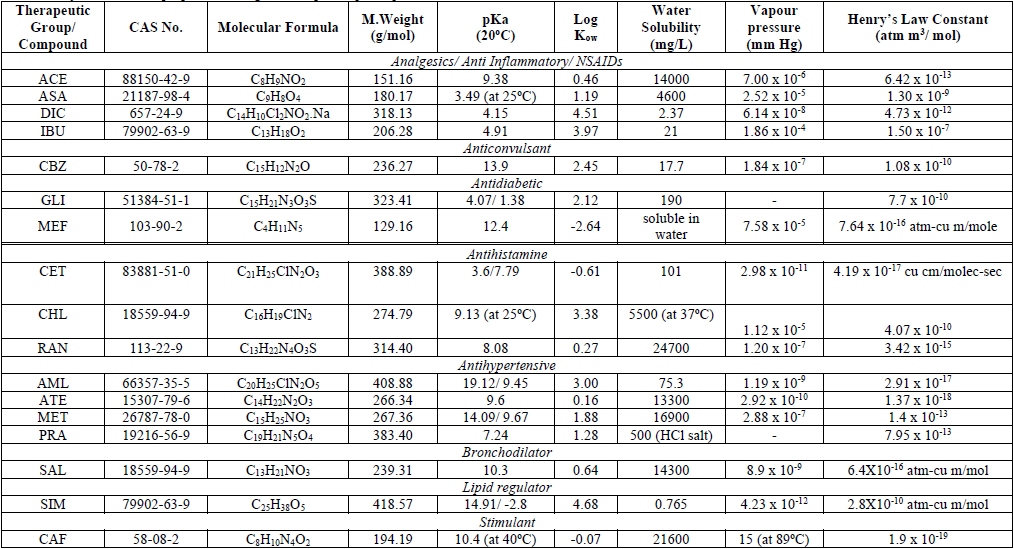

 cygnusmind
cygnusmind